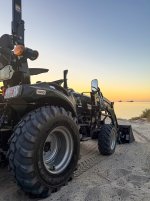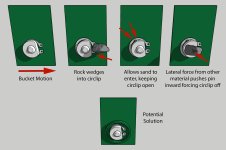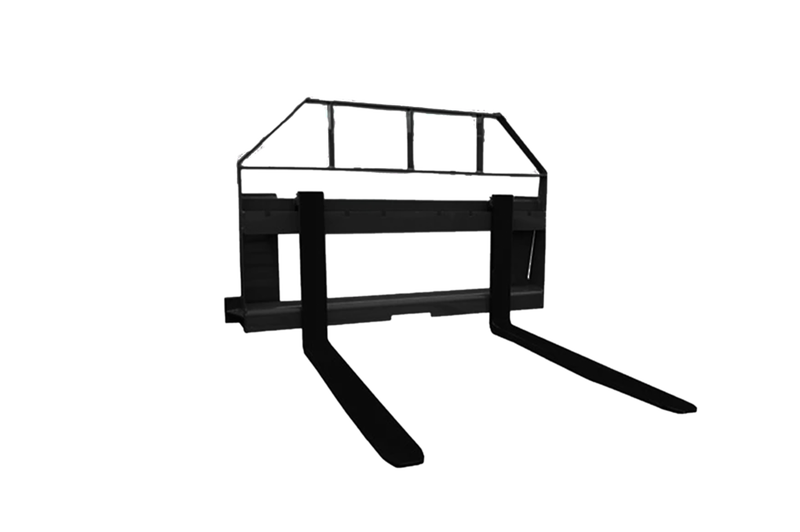40-ish Hour Review Part One
TLDR: Some minor issues, but overall a very positive experience, especially with customer support. The tractor performs well, is appropriately powered, and is quite capable.
I am coming up on the 50-hour service with about 42 hours on the clock. I decided to post a review of my experiences with my Summit TX25 with LX85 loader and throw in a review of the attachments I am currently using on it.
The tractor is located in Mexico, in northern Baja California. Importation was complicated and took a long time to figure out, but it finally arrived six weeks ago, and I have been using it almost daily, through June into July of 2025. The location is an arid coastal desert, and the temperatures in which I have been operating have ranged over this period from 85°F to 110°F, with most operation in the 95°F to 105°F range.
The terrain varies from deep, soft beach sand to dusty, hard-packed, rock-strewn desert.

The type of work I have been doing over this period has been leveling roads, clearing debris, and pulling rocks out of dirt roadbeds, landscaping that includes moving many tons of sand and boulders ranging from 50 to 500 pounds or more.
Commentary on the tractor purchase and the tractor itself.
I had an odd situation as I was purchasing to import directly to Mexico, which required delivery to a customs house in California on the southern border. I ordered online through Runnings as there are no dealers in California at this time. The people at Runnings were very helpful in making this happen. This required many phone calls as we sorted through how to deal with delivery and tax issues.
Once I placed the order, I received excellent communication and support from Summit regarding delivery timing and logistics. Because of the somewhat complicated delivery logistics, Summit’s founder and CEO even called and texted on several occasions to ensure everything was going well. The tractor was delivered rapidly (30 hours after leaving the Atlanta factory). It arrived about an hour later than projected, which was pretty amazing for a trip from Atlanta to Calexico, California. $500 shipping was a great deal for the delivery, which I am certain was a loss for the company at that distance. It then spent a week clearing customs, and I had it shipped the rest of the way to my house in Baja by a Mexican shipper.
I spent the next 72 hours familiarizing myself with the tractor by moving sand around with the bucket and box blade. At this point, three issues became apparent with the tractor.
Tractor Performance: Other than the above three really minor issues, the tractor has performed wonderfully. No issues running in the heat. It runs cool, and it is much quieter than I expected.
I inquired on this forum about using spacers on the rear wheels. While I do not have a lot of hills, I can get on some weird angles on sand dunes, so I thought a little extra width may be beneficial. I was informed that this would void the warranty regarding rear axle issues, so I decided against it. So far, though, I have found the tractor very stable without them. The weight of the tractor with the Rim Guard makes it feel as stable as a larger tractor. I have not spent a lot of time on tractors, but comparing the little time I have spent working on a farm with slightly larger 40-50HP tractors, the Summit feels similarly stable with the relative lift capacity of the front loader. I now feel that spacers are not needed. Additionally, the 54-inch stock track width allows me to get into some really tight spaces. The spacers would reduce this benefit. After initially being concerned that the tractor may be a little small, I am finding myself really happy with the size.
The driver position is good, and the seat is one of the most comfortable in this size of tractor. The adjustable armrests are great. Steps on both sides of the rubber mat all make the operation very comfortable, and I feel safer when operating—nearly all the time—wearing flip-flops. The mirrors are in a great location. I am often out working between 6 am and 8 am and 6 pm and 8 pm due to the heat. So the sun is at a low angle, and it is simple just to reach and adjust them so they aren't reflecting the glaring sun directly into my eyes (boy, do I need a canopy badly).
Power: The power seems very appropriate for the tractor, although there are times when a bit more would be helpful. This usually occurs when hauling something heavy, like a load of gravel in the bucket up a slope in deep sand. The gearing is appropriate for a two-speed transmission. I wouldn't want to move any faster in high, and wouldn't want the low any lower. A mid-range would allow a higher work speed in certain situations when moving lighter material around, but I rarely find a situation where it really needs it.
Traction: I was concerned about the deep sand and thought that perhaps I would need to install some radial turf tires to air way down to get more flotation. I may still do this in the future, but so far it has been doing quite well. The use of the heel-operated rear diff lock is convenient and has gotten me quickly out of any situation where I ran into traction challenges. I did get into a situation where I had to move about eight yards of sand in a narrow area on the side of my house, and while smoothing it out, I was unable to back up the slope I had made—even with the locked rear differential. This was about 16-20 inches of dry, freshly dumped beach sand that was not compacted. I had to drive forward down the slope, turn around, and drive forward up the slope to get out. I don't think better tires would have made too much of a difference. I most likely will stay with the R-14s because sometimes, when I am out in the desert crawling over sharp rocks, I like the extra rubber.
Three-Point Hitch: This seems to work well, although it doesn't lift as high as I would like at times. I think this may be a common issue with this size tractor. Fortunately, both the left and right arms are adjustable for tilting, rather than the traditional one side being adjustable, so you can crank them both tighter evenly to get a little extra height.
To be continued...
TLDR: Some minor issues, but overall a very positive experience, especially with customer support. The tractor performs well, is appropriately powered, and is quite capable.
I am coming up on the 50-hour service with about 42 hours on the clock. I decided to post a review of my experiences with my Summit TX25 with LX85 loader and throw in a review of the attachments I am currently using on it.
The tractor is located in Mexico, in northern Baja California. Importation was complicated and took a long time to figure out, but it finally arrived six weeks ago, and I have been using it almost daily, through June into July of 2025. The location is an arid coastal desert, and the temperatures in which I have been operating have ranged over this period from 85°F to 110°F, with most operation in the 95°F to 105°F range.
The terrain varies from deep, soft beach sand to dusty, hard-packed, rock-strewn desert.

The type of work I have been doing over this period has been leveling roads, clearing debris, and pulling rocks out of dirt roadbeds, landscaping that includes moving many tons of sand and boulders ranging from 50 to 500 pounds or more.
Commentary on the tractor purchase and the tractor itself.
I had an odd situation as I was purchasing to import directly to Mexico, which required delivery to a customs house in California on the southern border. I ordered online through Runnings as there are no dealers in California at this time. The people at Runnings were very helpful in making this happen. This required many phone calls as we sorted through how to deal with delivery and tax issues.
Once I placed the order, I received excellent communication and support from Summit regarding delivery timing and logistics. Because of the somewhat complicated delivery logistics, Summit’s founder and CEO even called and texted on several occasions to ensure everything was going well. The tractor was delivered rapidly (30 hours after leaving the Atlanta factory). It arrived about an hour later than projected, which was pretty amazing for a trip from Atlanta to Calexico, California. $500 shipping was a great deal for the delivery, which I am certain was a loss for the company at that distance. It then spent a week clearing customs, and I had it shipped the rest of the way to my house in Baja by a Mexican shipper.
I spent the next 72 hours familiarizing myself with the tractor by moving sand around with the bucket and box blade. At this point, three issues became apparent with the tractor.
1). The rear tires were effectively overfilled with RimGuard. I say effectively, because this is how it manifested for me. I run the tires at the lowest pressure recommended by the manual because I operate primarily on soft sand, and I need maximum traction. From the factory, the tires are logically inflated at the high end of the range recommended by the manual for maximum weight capacity. The amount of Rim Guard was right up to the valve stem at this pressure. This makes it impossible to accurately check the air pressure once I have dropped the pressure down a little. In other words, when I initially began to let the first one or two pounds out with the stem at 12 o’clock, I got air at first, but within a few seconds, it began spewing Rim Guard. (I ruined a nice tire gauge by getting it gummed up by this stuff.) The temperature was in the 90s, but that should not have caused that much expansion. I thought that this may be related to the lower air pressures I was targeting. Letting air out could be causing the tire to flatten out slightly, making the internal level of the Rim Guard rise slightly. In the end, I jacked up the rear of the tractor to take the pressure off the bottom of the tires, but still had to remove close to two gallons of Rim Guard from each rear tire. This was an extremely messy process, and while Rim Guard does not have a particularly offensive odor, the smell now brings up memories of the mess. Fortunately, it washes off very easily with just water.
2). The set screw for the loader control handle came loose after about 12 hours of operation, causing it to rotate side to side. It was a very simple fix with a hex wrench that only required pulling the boot down a couple of inches and tightening the set screw. It was never in danger of coming off.
3). The Dipstick: I checked the oil when I first received the tractor and again after a couple of hours of use. I had read about the difficulty of finding the dipstick hole when replacing it, so I was conscious of being careful to locate the hole when putting it back in. Over the next 36 hours, I noticed a little fluid dripping from the bottom of the tractor, which I assumed was hydraulic fluid. I worried that I had hit or scraped a rock or something. After investigating, I discovered that the last time I replaced the dipstick—while I did get it into the hole with the help of a flashlight—the bottom of the rubber mushroom-shaped dipstick gasket caught on the edge of the tube, making it feel like it had seated properly. What I learned is that the dipstick comes in at an angle, which requires you to watch it from the side as it goes in to ensure the plug/gasket aligns with the angle of the tube, even if the stick is already in the tube. The plug bottom (the bottom of the “mushroom stem”) ended up sitting on the top edge of the tube, rather than going into the tube, so the “mushroom top” didn't seat. This lets a small amount of oil randomly spatter out. After I cleaned everything up and got the dipstick in properly, it was fine. It's not necessarily a design flaw, although a longer tube and stick to eliminate this easy-to-make error would be beneficial. From now on, I will just take extra care and kneel down with a flashlight when replacing the dipstick when checking the oil to ensure the dipstick is not only in, but that its plug/gasket is properly seated..
Tractor Performance: Other than the above three really minor issues, the tractor has performed wonderfully. No issues running in the heat. It runs cool, and it is much quieter than I expected.
I inquired on this forum about using spacers on the rear wheels. While I do not have a lot of hills, I can get on some weird angles on sand dunes, so I thought a little extra width may be beneficial. I was informed that this would void the warranty regarding rear axle issues, so I decided against it. So far, though, I have found the tractor very stable without them. The weight of the tractor with the Rim Guard makes it feel as stable as a larger tractor. I have not spent a lot of time on tractors, but comparing the little time I have spent working on a farm with slightly larger 40-50HP tractors, the Summit feels similarly stable with the relative lift capacity of the front loader. I now feel that spacers are not needed. Additionally, the 54-inch stock track width allows me to get into some really tight spaces. The spacers would reduce this benefit. After initially being concerned that the tractor may be a little small, I am finding myself really happy with the size.
The driver position is good, and the seat is one of the most comfortable in this size of tractor. The adjustable armrests are great. Steps on both sides of the rubber mat all make the operation very comfortable, and I feel safer when operating—nearly all the time—wearing flip-flops. The mirrors are in a great location. I am often out working between 6 am and 8 am and 6 pm and 8 pm due to the heat. So the sun is at a low angle, and it is simple just to reach and adjust them so they aren't reflecting the glaring sun directly into my eyes (boy, do I need a canopy badly).
Power: The power seems very appropriate for the tractor, although there are times when a bit more would be helpful. This usually occurs when hauling something heavy, like a load of gravel in the bucket up a slope in deep sand. The gearing is appropriate for a two-speed transmission. I wouldn't want to move any faster in high, and wouldn't want the low any lower. A mid-range would allow a higher work speed in certain situations when moving lighter material around, but I rarely find a situation where it really needs it.
Traction: I was concerned about the deep sand and thought that perhaps I would need to install some radial turf tires to air way down to get more flotation. I may still do this in the future, but so far it has been doing quite well. The use of the heel-operated rear diff lock is convenient and has gotten me quickly out of any situation where I ran into traction challenges. I did get into a situation where I had to move about eight yards of sand in a narrow area on the side of my house, and while smoothing it out, I was unable to back up the slope I had made—even with the locked rear differential. This was about 16-20 inches of dry, freshly dumped beach sand that was not compacted. I had to drive forward down the slope, turn around, and drive forward up the slope to get out. I don't think better tires would have made too much of a difference. I most likely will stay with the R-14s because sometimes, when I am out in the desert crawling over sharp rocks, I like the extra rubber.
Three-Point Hitch: This seems to work well, although it doesn't lift as high as I would like at times. I think this may be a common issue with this size tractor. Fortunately, both the left and right arms are adjustable for tilting, rather than the traditional one side being adjustable, so you can crank them both tighter evenly to get a little extra height.
To be continued...
Last edited:







